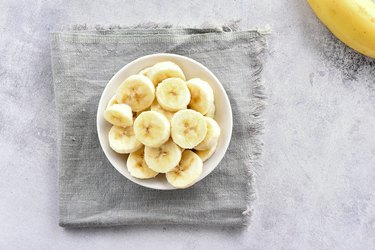
Bananas and leg cramps are often associated with each another. But not because bananas cause leg cramps; rather, bananas are considered a potential remedy for leg cramps because of the amount of potassium they contain. Research in the Wisconsin Medical Journal in 2017 noted that leg cramps are associated with a low potassium intake. If you have cramps after you eat bananas, it probably has something to do with an activity you just completed, a potassium deficiency or an underlying medical condition.
Bananas, Potassium and Leg Cramps
Video of the Day
A common denominator among the female participants with leg cramps in the Wisconsin Medical Journal study was a lower potassium intake than the group that didn't experience leg cramps. Potassium is an electrolyte mineral that carries electrical signals to your cells and helps your muscles contract. A muscle cramp is a sudden, painful contraction of the muscle. Everyone gets them sometimes, but if they happen regularly, it's a sign something may not be right, and low potassium may be the culprit.
Video of the Day
Your Potassium Needs
According to the Food and Nutrition Board of the Institute of Medicine, adult men and women need 4.7 mg of potassium per day. MedlinePlus reports that most people get enough potassium from their daily diet. If you're concerned, you can have your doctor run a blood test to check your blood levels, which should be between 3.6 and 5.2 millimoles per liter, according to University Health News.
Symptoms of a low potassium level include muscle cramps, fatigue, weakness, frequent thirst, depression and confusion. Additionally, intestinal paralysis, abdominal pain, bloating, abdominal cramping, constipation, nausea or vomiting can occur. More serious symptoms of low potassium can include arrhythmia, which is an abnormal heart rhythm. In certain circumstances, a very low potassium level — less than 2.5 millimoles per liter — can be life-threatening.
Read more: Health Benefits of Isotonic Drinks
Other Foods For Leg Cramps
To get 4.7 grams — or 4,700 mg — of potassium each day is no small feat. One medium banana has 422 mg, according to Health.gov. Other foods with substantial potassium content that help with muscle cramps include:
- One sweet potato: 694 mg
- An 8-ounce container of plain nonfat yogurt: 579 mg
- One-half cup of cooked lima beans: 484 mg
- One 3-ounce serving of halibut: 490 mg
- One-half cup of cooked spinach: 419 mg
- One-fourth cup of dried peaches: 398 mg
Plenty of other foods contain potassium in good supply. As long as you're healthy and eating a balanced diet, you shouldn't have trouble staying on top of your daily needs.
Special Populations and Potassium Deficiency
Certain populations may have more trouble getting adequate potassium from their diets, according to the National Institutes of Health. This includes those with inflammatory bowel disease — like Crohn's and ulcerative colitis. Certain medications such as laxatives and diuretics can also cause you to lose more potassium, which increases your needs. In addition, athletes who engage in heavy training in hot conditions may experience potassium deficiency that requires an increased need for the mineral.
Read more: Foods and Drinks High in Potassium
- Wisconsin Medical Journal: Muscle Cramps Do Not Improve With Correction of Vitamin D Insufficiency
- MedlinePlus: Potassium
- Food and Nutrition Board of the Institute of Medicine: Dietary Reference Intakes (DRIs): Recommended Dietary Allowances and Adequate Intakes, Elements
- University Health News: Potassium Deficiency? 10 Signs You’re Not Getting Enough
- Health.gov: Appendix B-1. Food Sources of Potassium
- National Institutes of Health: Potassium
- Albion Minerals: Minerals Critical for Cognitive Function